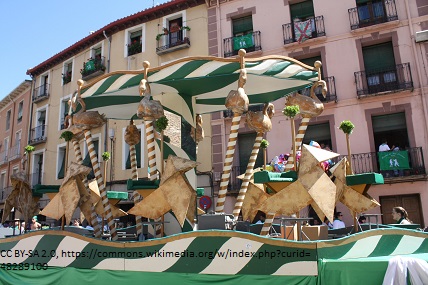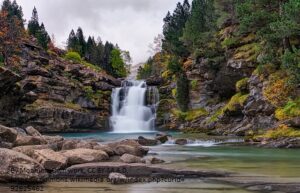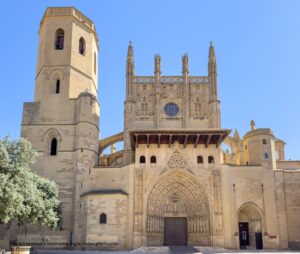Huesca Guide
Huesca's Fiestas
Though modest in size, Huesca comes alive throughout the year with a vibrant array of fiestas, where centuries-old customs blend with modern celebrations. These festivals offer an authentic insight into the soul of Aragon and are a must-see for anyone visiting the region. Below, we explore the most iconic fiestas in Huesca and what makes each one special.
Fiestas de San Lorenzo (10–15 August)
Arguably the most famous of Huesca’s festivals, San Lorenzo is the city’s patron saint celebration and a deeply cherished event. Taking place every year in mid-August, it transforms the city into a sea of white and green — the traditional colours of the festival.

The streets are adorned with flowers, balconies are festooned with green scarves, and locals dress in white with green sashes. The festivities begin on 9 August with a chupinazo (firework rocket) from the Town Hall balcony, followed by six days of religious processions, concerts, open-air dances, bullfights, and giants and big-heads parades. A key moment is the offering of flowers to San Lorenzo in the basilica, showcasing the community’s devotion.
Semana Santa (Holy Week)
Like many parts of Spain, Huesca commemorates the events of Easter with great solemnity and ceremony. Semana Santa in Huesca is known for its deeply moving processions, some of which date back to the Middle Ages. Members of religious brotherhoods, dressed in traditional robes and hoods, carry elaborate pasos (floats with religious sculptures) through the streets, accompanied by sombre drumming and chants.
While reflective and reverent, the week also provides a striking cultural experience for visitors. The processions are particularly notable for their historical accuracy, and the city’s small size allows for an intimate and accessible atmosphere.
Fiesta de las Miguelas (Easter Monday)
A charming local celebration unique to Huesca, the Fiesta de las Miguelas takes place on Easter Monday. It traces its origins to a medieval custom where local bakers, known as “miguelas”, would hand out sweets and bread to the poor.
Today, the tradition continues in the form of families heading out to the countryside or nearby hills, such as Montearagón or San Jorge, to enjoy a picnic and share mona de Pascua (a sweet Easter cake). It’s a more relaxed, family-oriented occasion that reflects the strong communal ties within Huesca.
San Vicente (22 January)
This winter festival honours Saint Vincent, another of Huesca’s patrons. Held in the depths of January, it’s a warming celebration full of light and flavour. One of the most symbolic features is the distribution of bread rolls, commemorating the saint’s acts of charity.
Bonfires, known as hogueras, are lit throughout the city, and locals gather around them to grill local sausages and enjoy traditional music and wine. Despite the cold, San Vicente is a lively and social event that draws families and neighbours together.
La Noche de las Ánimas (31 October – 1 November)
While Halloween has gained popularity in recent years, Huesca has its own ancestral version in the form of La Noche de las Ánimas — the Night of the Souls. Rooted in Celtic and Christian traditions, this celebration involves lighting candles in windows and cemeteries to guide the spirits of the dead.
In recent years, local cultural associations have revived the event with theatrical performances, storytelling sessions, and eerie processions through the old town, making it a uniquely atmospheric experience.
San Jorge (23 April)
San Jorge, the patron saint of Aragon, is celebrated with pride across the region, and Huesca is no exception. Falling on 23 April, the day also coincides with World Book Day, adding a literary flair to the occasion. Public readings, book fairs, and cultural activities are held throughout the city, while families often head to nearby hills for barbecues and picnics
Related articles

Getting around Huesca and the surrounding region
Huesca may not have a sprawling metro or tram network like larger Spanish cities, but its public transport is reliable,

Typical food and drink to try in Huesca
From comforting stews to delicate pastries, the food and drink of Huesca reflect both the rugged terrain and the refined

Days out from the city of Huesca
Whilst Huesca the city has much to offer, one of the real attractions for some are the opportunities to visit

Top 10 things to do in Huesca
Many people ask “Is Huesca worth visiting?” Whilst it may not be on every traveller’s radar, that’s precisely what makes
